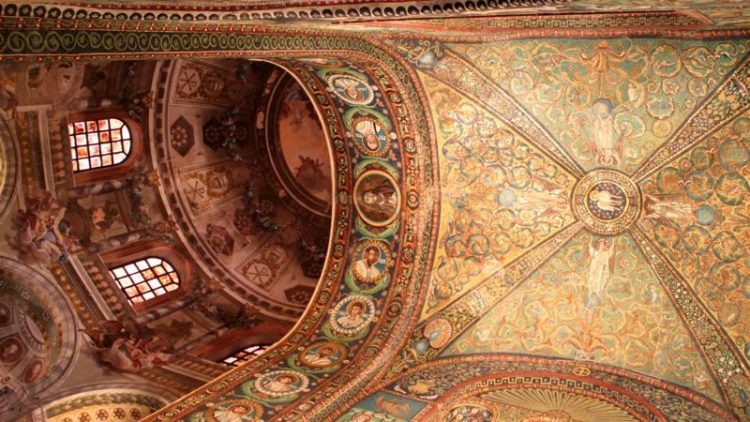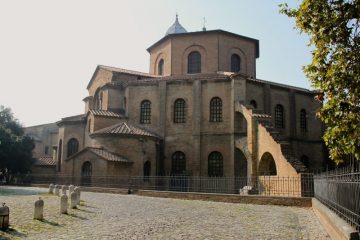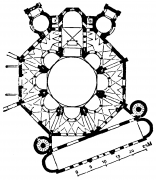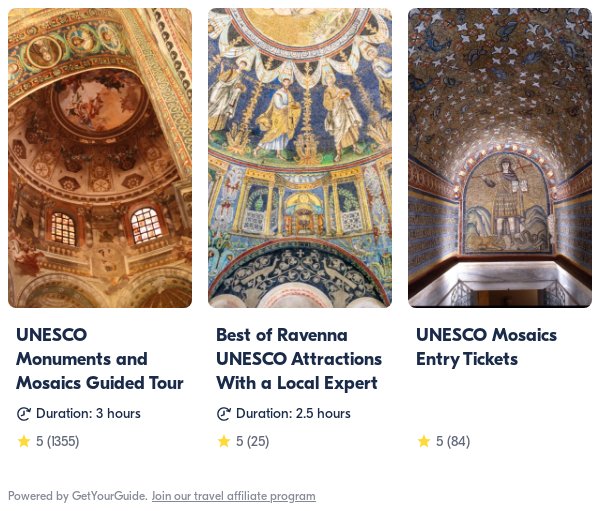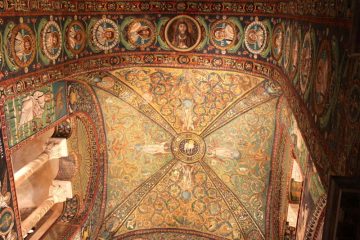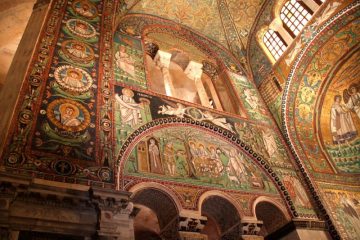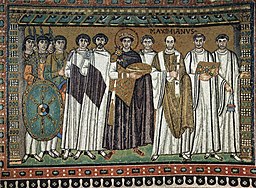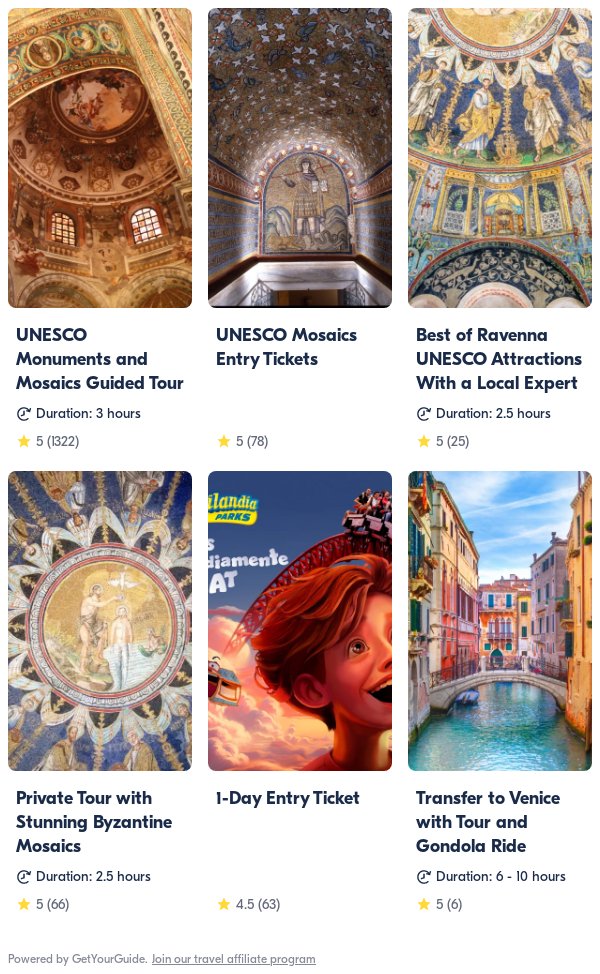The Basilica of San Vitale is a highlight of any visit to see the Byzantine wall mosaics in Ravenna, a town popular with day trippers from Venice and Bologna. The Basilica of San Vitale in Ravenna has the largest Byzantine mosaics outside Istanbul and is the best example of Justinian church architecture in existence.
The Basilica of San Vitale is one of the top sights to see in Ravenna, Italy. This church dates from the early sixth century and is as interesting for its architecture as for its Byzantine wall mosaics. It influenced church architecture for centuries while the mosaics are the largest and best-preserved outside Istanbul. San Vitale is also the only church from the time of Justinian the Great that has survived intact and unaltered to the present. The small Mausoleum of Galla Placidia in the garden is also of significant art interest and one of the highlights of visiting Ravenna.
The Basilica of San Vitale in Ravenna
Construction of the Church of San Vitale started in AD 525 at the end of the reign of Ostrogoth King Theodoric the Great but was completed around AD 547 under the reign of Emperor Justinian the Great. The architecture and decorations show clear eastern and Byzantine influences, including large flat stones popular as building material in Justinian constructions.
The church has an octagonal center with a central dome. This octagon is surrounded by high arches, which give access to a series of arcades. This gives the building a surprising lightness, both in terms of illumination and building structure. Basilica in the name clearly refers to its ecclesiastical status and not to triple-nave architecture.
San Vitale influenced church architecture for centuries. One of the best-known examples was the Imperial Cathedral of Charlemagne in Aachen, Germany, which was greatly influenced by what the Franks saw in Ravenna.
San Vitale largely kept its original design unaltered. Minor additions include the cross vaulting and a new eastern portal. Other additions and decorations have been stripped away during restoration projects since the nineteenth century.
The central dome measures 15.70 m and is typically for this period made of rings of clay pipes. (Outside, the dome is hidden by a pyramid roof.) The Baroque dome painting and other frescos are from the eighteenth century.
Some of the floor mosaics in San Vitale, especially at the periphery, are original Byzantine work but most, including the labyrinth, are more recent.
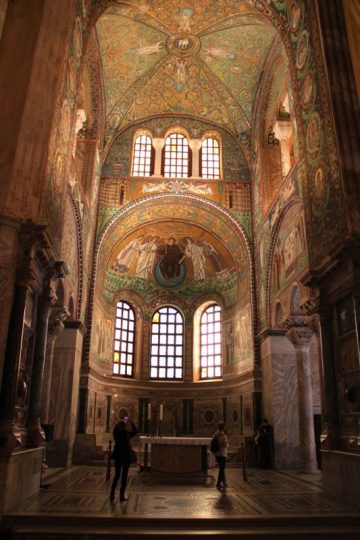

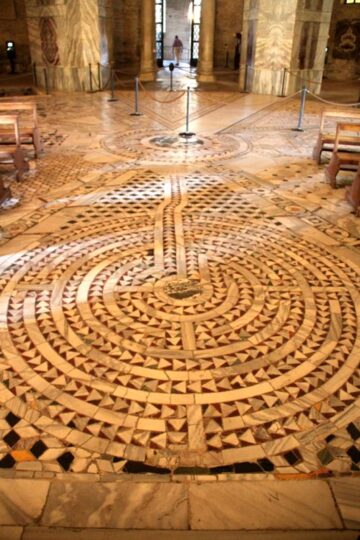
Mosaics of the Basilica of San Vitale
In addition to the magnificent architecture, the mosaics in San Vitale are the main attractions. These are considered the largest and best-preserved Byzantine mosaics outside modern-day Istanbul.
The whole apsis and altar area is still covered by original mosaics. The intrados of the triumphal arch features fifteen figures including Christ and the twelve apostles. The vault of the presbytery is decorated with numerous plants and animals with the Lamb of God at the center on a medallion carried by four angles.
Most of the mosaics in the altar area illustrate Old Testament figures and events, including scenes from the life of Abraham, Isaac, Moses, Jeremiah, and Isaiah.
The four evangelists with their respective symbols are represented in full-length figures adjacent to the windows.
In the theophany of the apsis sits a beardless Christ on a blue globe that represents the universe. He offers Saint Vitale the crown of martyrdom while Bishop Ecclesius offers Christ a model of the church.
As he was only one of the church builders, it is fairly certain that this specific mosaic is from soon after 525.
Justinian and Theodora Mosaics in San Vitale
The two most famous mosaics in San Vitale are definitely slightly younger and must date after 540, when the Byzantines had re-conquered Ravenna for the (Eastern) Roman Empire. These mosaics are political statements showing Emperor Justinian I (the Great) and his wife Theodora as rulers of Ravenna. (Justinian never actually visited Ravenna.)
The Justinian Mosaic is low on the northern apse sidewall. It shows Justinian I, emperor of the (East) Roman Empire clad in imperial purple with a saint-like halo.
He is surrounded by court officials and church leaders, of which Bishop Maximianus was the only one to manage working his name into the mosaic.
On the southern apse sidewall is the Theodora Mosaic. Here the bejeweled wife of the emperor also has a saint’s halo and is followed by court ladies.
The expensive Byzantine court clothes are reproduced in great detail. Theodora was highly controversial in her time, as she was one of the most powerful women during the whole Roman era.
Visiting the Church of San Vitale in Ravenna
The Basilica di San Vitale is entered from the back through the complex and cloisters that house the National Museum. (Visiting the museum is optional and has separate admission tickets from the mosaic sites passes.) Don’t miss the Mausoleum of Galla Placida in the back garden of the basilica — it is a highlight of any visit to Ravenna and requires time-slot reservations.
- See Visiting the UNESCO-listed Sites in Ravenna for opening hours and ticket information.
NEXT: Mausoleum of Galla Placidia
More Articles on Ravenna, Italy
Time-slot reservations are currently essential to see the Mausoleum of Galla Placida and the Neonian Baptistry in Ravenna. This is easiest done when buying the tickets online.
- Top Sights to See in Ravenna
- UNESCO-Listed Sites in Ravenna
- Visiting UNESCO-Listed Sites in Ravenna – Opening Hours and Tickets
- The Neonian Baptistery & Archbishop’s Chapel
- The Arian Baptistery
- Basilica of Sant’Apollinare Nuovo
- Basilica of San Vitale
- Mausoleum of Galla Placidia
- Mausoleum of Theodoric
Book Guided tours of Ravenna — tours are generally three hours. For tours not including admission fees, around €12 per person must be added. Small groups and families may find better value in private tours.
